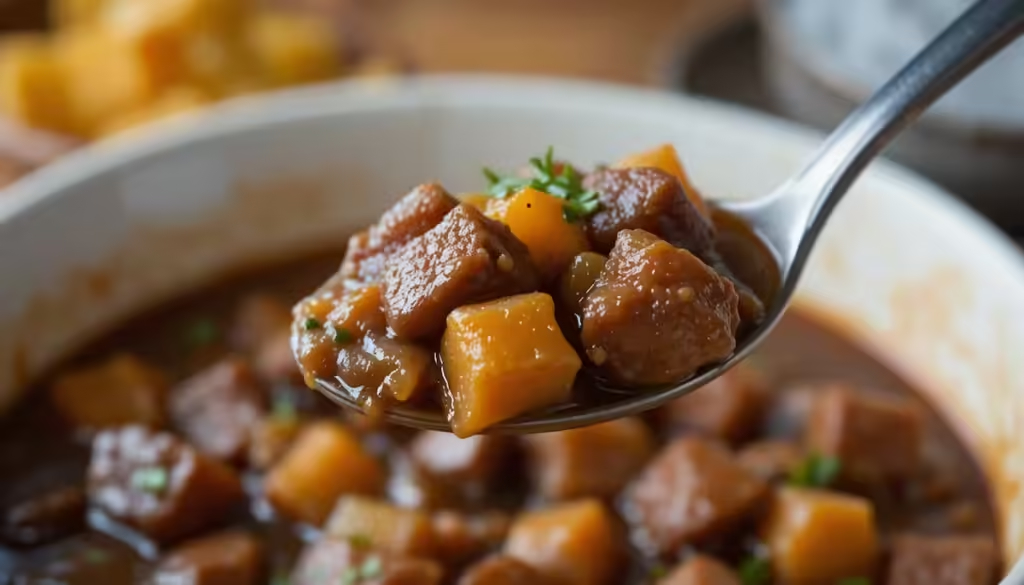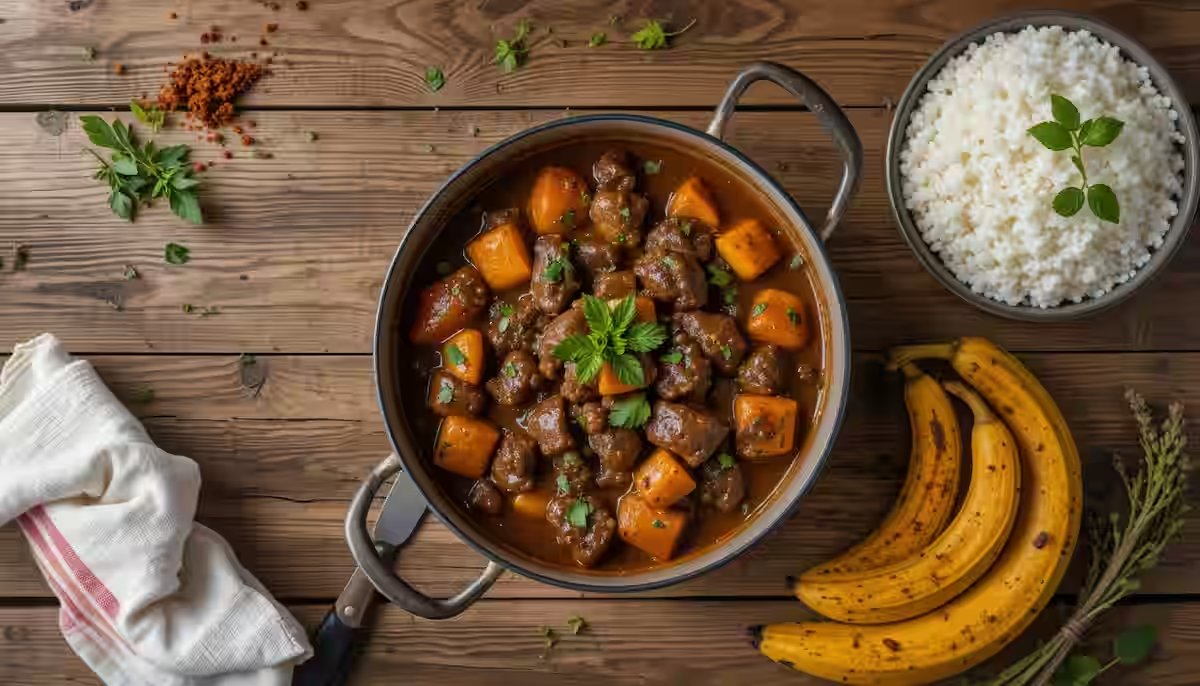Puerto Rican beef stew is a hearty and flavorful dish. It’s a staple in many households. This stew is known for its rich taste. It often features tender beef and root vegetables. It is seasoned with a blend of aromatic spices.
The Amazing Origins of Puerto Rican Beef Stew
The history of Puerto Rican beef stew, or carne guisada, is deeply intertwined. It reflects the island’s cultural heritage. This delicious stew showcases a mix of influences. These include Spanish, African, and indigenous Taíno traditions. Over time, each generation has added their own touch. This has led to variations in recipes across the island. Many families have their own secret version. The basic idea always remains the same. It’s about using simple ingredients to create a complex flavor.
Cultural Significance
Puerto Rican beef stew is more than just a meal. It’s a part of many celebrations. It appears at family gatherings and special occasions. It offers a sense of comfort and nostalgia. The aromas bring back childhood memories for many. The dish provides warmth and a feeling of home. It also represents the resourcefulness of Puerto Rican cooking. This cooking often uses locally available ingredients. The recipe has been passed down through generations. It’s a connection to the past and to family roots. Therefore, the dish plays an important role in maintaining cultural identity.
Essential Ingredients for Puerto Rican Beef Stew
Making a traditional Puerto Rican beef stew involves some key ingredients. These are essential for the dish’s authentic flavor. The quality and freshness of ingredients can affect the taste. This attention to detail is why it is so good. Let’s dive deeper into the components that you need.
Meat Selection
The choice of beef is very important. Many people prefer using chuck roast for this stew. It’s affordable, and it becomes incredibly tender when cooked low and slow. Other cuts, like brisket or stew meat, work well too. The key is to choose a cut that has some fat. This fat helps keep the meat moist. The meat should be cut into good-sized cubes. About 1-2 inches is usually perfect. The beef gets browned before adding liquid to deepen flavor. This browning is a crucial step.
Vegetables and Root Vegetables
Root vegetables play a big role in this recipe. They add texture and body. Typical choices include potatoes, carrots, and yuca. Yuca is a starchy root vegetable. It’s popular in Puerto Rican cooking. It gives the stew a unique, slightly sweet taste. Other options might include sweet potatoes or plantains. The selection can be adjusted based on personal preference. These vegetables are usually cut into large chunks. They cook alongside the beef. This results in a harmonious blend of flavors.
Sofrito and Spices
Sofrito is the base of most Puerto Rican cooking. It is a mix of peppers, onions, garlic, and herbs. Each family usually has its own unique version of it. It provides depth of flavor. It’s crucial for the dish’s rich taste.
Liquids and Other Ingredients
The liquids used in Puerto Rican beef stew also play an important part. Water or beef broth are typically used. They create the stew’s base. Some recipes add tomato sauce for a touch of acidity. It can also provide a richer color. Olives and capers might also be included. These add a salty, briny note. These small details can take the stew to the next level. Finally, some cooks add a touch of vinegar or a splash of wine. These add more complexity to the flavor.
The Incredible Process of Making Puerto Rican Beef Stew
The process of making Puerto Rican beef stew isn’t difficult. It does require time and patience. Cooking it low and slow lets all the flavors blend. It’s where the magic happens. Follow these steps for a great result.
Step-by-Step Guide
Next, sauté the sofrito in the same pot for a few minutes. It should be fragrant. Then, add the spices and cook for another minute.
Add the beef back to the pot. Then, pour in the liquid. It should cover the beef. Bring the mixture to a simmer. Reduce the heat to low.
Tips and Tricks
There are a few tricks to making the best stew. First, don’t rush the browning of the beef. It adds depth. Also, taste as you go. Adjust seasonings as needed. Simmering the stew for a long time is very important. This allows the flavors to meld. It also makes the beef extra tender. Some cooks add a little bit of mashed pumpkin. This is for extra richness and thickness. You can also use a slow cooker. It’s a great alternative if you don’t have much time to watch the stew. The flavors may take longer to develop. But it still makes a really good stew.
Variations of Puerto Rican Beef Stew
While the core elements of carne guisada remain constant, there are numerous variations. These cater to different tastes and preferences. These variations often reflect the different regions within Puerto Rico. They also reflect individual family traditions.
Regional Differences
Different regions of Puerto Rico may have their own unique take on this stew. For example, some areas might add more green peppers or olives. Other areas might opt for a spicier flavor profile. The availability of local ingredients often influences regional variations. These subtle changes can result in diverse flavor combinations. Despite these differences, it is all still considered to be carne guisada. Image Placeholder: Different types of Puerto Rican beef stew served in various bowls. alt text: «variations of Puerto Rican beef stew»
Personal Twists
Many cooks make their own adjustments. Some people add potatoes or sweet potatoes. Others choose to include pumpkin. Some add a touch of wine or vinegar. These little personal twists can create really unique flavors. Experimenting with different ingredients is often a great way to discover your favorite version. The beauty of this stew is its adaptability. It encourages cooks to get creative in the kitchen.
Serving and Pairing Puerto Rican Beef Stew
The best way to enjoy Puerto Rican beef stew is with some great side dishes. The stew is very versatile. It pairs well with different kinds of food. It can be a main course or a part of a larger meal. It is delicious and can be enjoyed anytime.
Traditional Accompaniments
Traditionally, carne guisada is served with white rice. The rice soaks up all of the delicious sauce. It’s also often accompanied by tostones. These are twice-fried plantain slices. These are crispy and have a nice savory taste. A simple side salad adds a touch of freshness. It complements the richness of the stew. These traditional sides create a balanced and satisfying meal.
Other Options
You can get creative with side dishes too. Some people enjoy serving it with mashed potatoes or polenta. A side of boiled green bananas can also work. For a touch of sweetness, try serving it with some ripe plantains. The stew is very versatile. It can pair well with different types of dishes. These options can be adjusted depending on your taste. Image Placeholder: A table setting showcasing a bowl of Puerto Rican beef stew alongside white rice and tostones. alt text: «Traditional serving of Puerto Rican beef stew»
The Importance of Family and Tradition
Puerto Rican beef stew holds a special place in family traditions. It is often passed down from generation to generation. Each family has its own recipe. This is what makes this dish so special. It’s more than just a meal; it is a way to connect with the past.
Treasured Recipes
The recipes are often kept secret. The knowledge gets passed down through oral tradition. Grandmothers teach their grandchildren how to prepare it. This creates a strong link to their family’s history. This dish is about preserving culture. It is also about sharing a meal together. The act of cooking and eating becomes an important ritual. These family recipes are like a family heirloom. They are often treasured for generations. They create a sense of continuity.
Shared Memories
Gathering to eat carne guisada creates special memories. These memories become important parts of the family history. The aroma fills the house. It brings a feeling of comfort and belonging. The time spent together around the dinner table is priceless. This dish provides not only sustenance but also a sense of family. It reinforces the bond between family members. Every time you taste it, you recall warm memories. It’s about more than just good food. It’s about preserving the memories.

FAQ
How to make a Puerto Rican beef stew?
To make Puerto Rican beef stew, you’ll need beef, sofrito, root vegetables, and various spices. Brown the beef, sauté the sofrito, and add spices. Combine with liquid and simmer until the beef is tender. Add root vegetables and cook until tender. This process usually takes a couple of hours for best results.
What is the difference between guisada and guisado?
«Guisada» is the feminine form of the word in Spanish and usually refers to the dish or preparation itself, while «guisado» is the masculine form. In common usage, particularly when talking about food, “guisada” is often used for a stew or a saucy dish in Puerto Rico.
What is a Spanish beef stew called?
In Spanish, a beef stew is generally referred to as estofado de carne or guiso de carne. These terms are commonly used in Spain and other Spanish-speaking countries to describe a beef stew. However, the specific preparation and ingredients can vary by region.
What is a carne guisada?
Carne guisada is a Spanish term that directly translates to «stewed meat.» It generally refers to any type of meat that is stewed in a sauce. In Puerto Rico, carne guisada is specifically used to describe the hearty beef stew with root vegetables.

